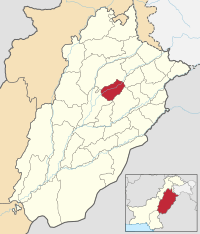Chiniot District
Chiniot District (Punjabi and Urdu: ضِلع چِنيوٹ), became the 36th district of the Punjab province of Pakistan in February 2009.[2] At an earlier time it was a tehsil of Jhang District.
Chiniot District ضلع چنیوٹ | |
|---|---|
 Map of Punjab with Chiniot District highlighted | |
| Country | Pakistan |
| Province | Punjab |
| Division | Faisalabad Division |
| Established | 2 February 2009 |
| Headquarters | Chiniot |
| Government | |
| • District Coordination Officer | Irshad Ahmed |
| Area | |
| • District | 2,643 km2 (1,020 sq mi) |
| Population | |
| • District | 1,369,740 |
| • Density | 520/km2 (1,300/sq mi) |
| • Urban | 422,538 |
| • Rural | 947,202 |
| Time zone | UTC+5 (PST) |
| Number of Tehsils | 3 |
History
Chiniot region was an agricultural region with forests during the Indus Valley Civilization. The Vedic period is characterized by Indo-Aryan culture that migrated from Central Asia and settled in Punjab region. The Kambojas, Daradas, Kaikayas, Madras, Pauravas, Yaudheyas, Malavas and Kurus invaded, settled and ruled ancient Punjab region. After overrunning the Achaemenid Empire in 331 BCE, Alexander marched into present-day Punjab region with an army of 50,000. The Chiniot region was ruled by Maurya Empire, Indo-Greek kingdom, Kushan Empire, Gupta Empire, White Huns, Kushano-Hephthalites and Shahi kingdoms.
In 997 CE, Sultan Mahmud Ghaznavi, took over the Ghaznavid dynasty empire established by his father, Sultan Sebuktegin, In 1005 he conquered the Shahis in Kabul in 1005, and followed it by the conquests of Punjab region. The Delhi Sultanate and later Mughal Empire ruled the region. The Punjab region became predominantly Muslim due to missionary Sufi saints whose dargahs dot the landscape of Punjab region.
After the decline of the Mughal Empire, the Sikh Empire conquered Narowal District. The Muslims faced restrictions during the Sikh rule. The British took over Chiniot District in 1848.
The predominantly Muslim population supported Muslim League and Pakistan Movement. After the independence of Pakistan in 1947, the minority Hindus and Sikhs migrated to India while the Muslim refugees from India settled in the Chiniot District.
"Chiniot" name is from Chandan Khan sister of Malik Machchhe Khan, Raja of Chiniot, a khokhar rajput clan. Mari tappa (founded raja badal khan khokhar rajput)was not then populated, but andheri was flourishing, and north of it lay the dhaular, or abode of Rani chandan, which was called chandniot, now chiniot. Or some say its name is based on as, literally "OT" (Behind/Across) of "CHIN-ab river", hence Chiniot. According to Sir Denzil Ibbetson. Panjab Castes, A glossary of tribes and caste of Punjab by H.D. ROSE. Chiniot was known for its master crafted furniture, not only in Pakistan, but all over the world. Its highly special and master craft Jharokhas are known in the whole country.[3]
On 2 February 2009, Chief Minister Shahbaz Sharif formally approved the creation of Chiniot as the 36th district of Punjab province on the behalf of Molana Ilyas Ahmed Chinioti.[4] Calls for Chiniot to be made a district date back to 2005, when a movement was a launched to elevate the former tehsil to district level. The movement died down when the public were assured the next Nazim would be from Chiniot – however this was not to be the case.[5]
Rana Tahir-the maiden DCO Chiniot along with Mr Hamza Shahbaz Sharif, raised the flag of Pakistan on DCO office on the fine morning of 1 July 2009. The efforts of Rana Tahir in giving a proper developed outlook to the infant district will find a place in history and cannot be over-emphasized. Mr Dilmeir Khan appointed as first district accounts officer and Mr Fayaz Sunbal was appointed as First DPO Chiniot.
Language
According to the 1998 census, 96.8% of the population of Chiniot tehsil had Punjabi as the first language,[6] and 2.4% had Urdu.[7]
Fauna and flora
The fauna and flora of the district include: Jand trees (Prosopis spicigera), Karir (Capparis aphylla), Beri (Ziziphus jujuba), Van (Salvadora abeoides), Kikar (Acacia arabica), Shisham (Dalbergia ) and Aak (Calotropis hamiltoni) are found within the district.[8]
Architecture
The Omar Hayat Mahal (also known as Gulzar Manzil), is a 19th-century palace in Chiniot. (Badshahi Masjid) it was built by Nawab Saad Ullah Khan who was minister of Shah Jahan. It has same architecture as Shahi Masjid Lahore. Nawab Saad Ullah was minister in the cabinet of the Mughal Empire.
See also
References
- "DISTRICT AND TEHSIL LEVEL POPULATION SUMMARY WITH REGION BREAKUP: PUNJAB" (PDF). Pakistan Bureau of Statistics. 3 January 2018. Archived from the original (PDF) on 26 April 2018. Retrieved 25 April 2018.
- Archive | Your Source of News on the World Wide Web. Dawn.Com. Retrieved on 2011-11-04.
- TMA Chiniot Website Archived 12 November 2018 at the Wayback Machine. Tmachiniot.com. Retrieved on 2011-11-04.
- Chiniot gets district status: Rs500m for infrastructure. Dawn. Retrieved on 2011-11-04.
- Jhang nazim's choice sparks row in party. Dawn.com. Retrieved on 2011-11-04.
- The census report has "mother tongue", defined as the language of communication between parents and children.
- 1998 District Census report of Jhang. Census publication. 114. Islamabad: Population Census Organization, Statistics Division, Government of Pakistan. 2000. p. 95. Archived from the original on 20 December 2016. Retrieved 13 December 2016.
- Punjab Portal Archived 1 October 2011 at the Wayback Machine. Pportal.punjab.gov.pk (2008-08-26). Retrieved on 2011-11-04.

.png)